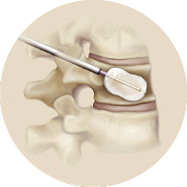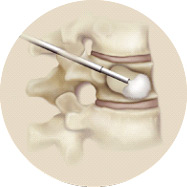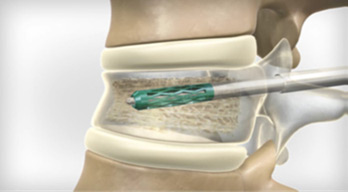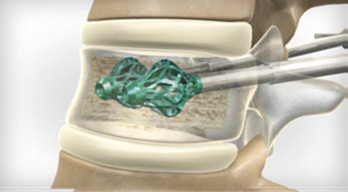What is kyphoplasty?
Kyphoplasty is a percutaneous (“through the skin”) minimally invasive procedure used to treat painful vertebral fractures of the thoracic and lumbar spine. It is a very effective treatment; in fact it has been used since 1999 in the US and since 2001 in Germany. International clinical studies show that this treatment leads to rapid pain relief and improve the quality of life.
The word 'Kyphoplasty' comes from the Greek. 'Kyphos'-'vertebrae' and ‘plastein’ -'to form'. Every single vertebrae of our body protects our spine and even if just one of them is porous, fragile or broken, the stability of our spine will be in danger. Ruptures not only cause severe pain but also lead to spinal deformity (kyphosis). When bone fragments enter the spinal canal they cause neurological deficits. A vertebral body that has been already reconstructed and stabilized, after his treatment will no longer be able to damage its structures or cause any risk to the stability of the spine. How can a vertebral body be stabilized?
Thanks to kyphoplasty special cement (calcium phosphate salt hydroxyapatite) is introduced through a cannula and is inserted into the vertebral body in the form of a gel. Then it becomes hard and ensures the stability of the previously porous and unstable vertebral body.
When is a balloon kyphoplasty necessary?
Vertebral fractures (annually 200,000 people suffer of vertebral fractures) are particularly common in women who suffer from osteoporosis (bone loss). (In Germany, at least six million people are affected by it.) This leads to instability of the spine, to vertebral deformities and height reduction. Osteoporosis is a major cause that leads to kyphoplasty, especially when conventional therapies are no longer able to alleviate the symptoms.
Kyphoplasty is used mainly be osteoporotic fractures, but also in cases with hemangiomas, osteolytic tumors, bone cyst, metastases and others.
Operation procedure - how the balloon kyphoplasty is done
The procedure takes about an hour, depending on the number of vertebral fractures. It can be done under general anesthesia but also with a local one.
In our clinic patients must be admitted the day before the operation. The nurses team will make sure you are ready for the operation, among other things they will make sure you are fasting.
Before the actual procedure, it must be ensured that other causes of pain can be ruled out. In addition, we need necessarily know if patients have allergy to the contrast agent. An X-ray in two levels of the thoracic spine and/or lumbar spine of the standing patient provides us accurate information in order to evaluate fracture and spinal alignments. Balloon kyphoplasty typically occurs in prone position. If the back has been disinfected and covered with sterile towels, the procedure can start. The surgery is done in several steps. It is minimally invasive and percutaneous ("through the skin").
Step 1: Under constant X-Ray control, we introduce one or two cannulas, the so-called working channels into the vertebral body. In this step, the porous interior of the bone is prepared for material implantation.
Step 2: We carry a balloon through the hollow instrument - usually two balloons are used - on each side of the vertebral body.
Step 3: The balloons are gently widened in order to raise the slumped areas of the vertebra back to their normal position. This expansion creates a cavity in the vertebral body.
Step 4: Through the cannula we remove the balloons.
Step 5: This is the step in which we inject bone cement. The cement hardened quickly, allowing the broken vertebra to be rebuilt and stabilized.
Now the spine is stable again.
Right after the operation
Immediately after the balloon kyphoplasty you will be welcomed into the recovery room where your health conditions will be controlled.
Post-operative days
After this treatment, the inpatient stay is usually about 6-10 days. Our nurses will encourage you to take your first steps and your employer will have to wait about 4 or 6 weeks before you start working again, even your car must hire a new driver for about 4 weeks. On the other hand, you can swim immediately, cycling after six weeks, golfing and tennis after ten weeks.
Advantages/Risks of a balloon kyphoplasty
You will feel the improvement of your back pain very quickly. It will be gone! Having your back mobility again will restore the quality of your life. In addition, Kyphoplasty restores also your vertebral height and corrects the alignment of your spine. But above all, since this is a minimally invasive therapy, the scar size will be equally minimal.
What should be clear is that kyphoplasty cannot eliminate osteoporosis, which means that after this treatment you should keep treating your osteoporosis, ideally with medical treatment and physiotherapy because it will help you to strengthen the muscles of your spine. Medication intervenes primarily in the calcium metabolism that is responsible for bone formation and degradation. Finally, the course of osteoporosis can be delayed by a healthy cell metabolism and possibly even stopped. Kyphoplasty is a minimally invasive procedure, but at the same time it is a surgical procedure that carries seldom risks and can also lead to side effects.
The Avicenna Clinic in Berlin is always willing to help you
Since the year 2001, the Avicenna Clinic is based in Berlin. Our doctors have at least 25 years of international experience in their respective fields (neurosurgery, spinal surgery, anesthesia, and orthopedics).
If you have severe back pain, a herniated disc or a suspected herniation, please contact us using the following information:











